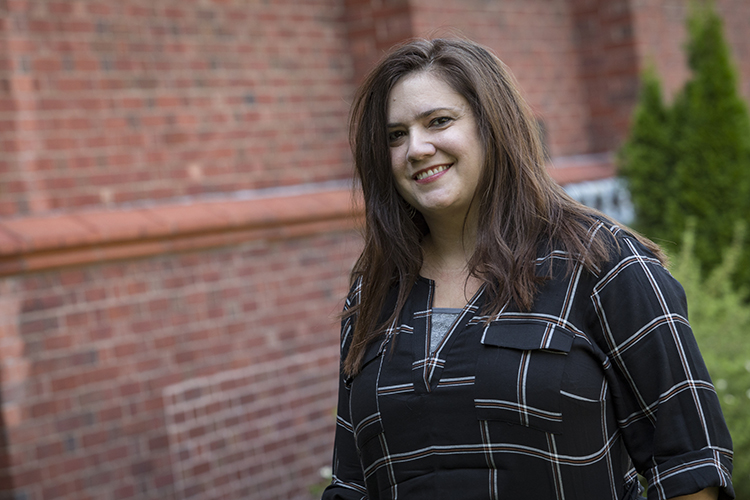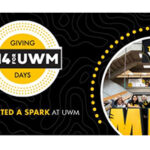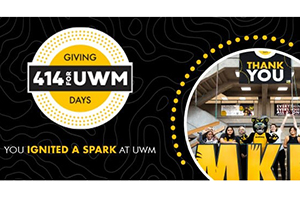From “Bones” to “Criminal Minds” and “Dexter” to “Murder, She Wrote,” crime and murder mysteries have fascinated television audiences for decades. For one UWM student, a fascination with real-life death mysteries spawned the pursuit of education and an eerily captivating website.
Rebekah Turner is a returning student pursuing certificates in forensic science and death investigation through UWM’s Helen Bader School of Social Welfare. Earlier this year, midway through her first semester at UWM, she launched a website — The Unidentified.
The Unidentified compiles palatable photos and renderings of discovered, but yet-to-be-identified, deceased people from cases around the country – some of which date back decades. The hope is that doing so will expedite the identification process and help close investigations. The image-driven nature of the site differs from existing sites that tend to include more graphic images and professionally focused data.
“Many great websites and organizations currently exist to raise awareness to cases of unidentified persons, but often they reach the same targeted community of advocates,” Turner said. “I created theunidentified.org to broaden this audience by removing apprehension of viewing a triggering image. In this way, the stories can be viewed and shared by those who wouldn’t normally consider themselves part of the advocacy community or those who may not have previously been aware that the unidentified person database exists.”

Her inspiration for the website, and her embarking on a new career, began with an attempt to crack a local case – the “Delafield Doe.”
The story of Delafield Doe begins in the early morning hours of Sept. 14, 1977. A Waukesha County sheriff’s deputy attempted to pull over a vehicle for faulty headlights. Unknown to the deputy, the vehicle was stolen, and the driver took off in an attempt to evade arrest. Before making it too far, the driver crashed, was ejected from the vehicle and died instantly. He was well-groomed, well-dressed and completely recognizable. However, he had no identification on him.
Despite multiple efforts by the Waukesha County Sheriff’s Department and the Waukesha County coroner to distribute photographs and details of the case to various agencies with hopes of having the man identified, nothing turned up. In 2015, he was exhumed for DNA analysis – still, nothing. Now, 41 years later, he remains unidentified.

A native of Elm Grove, Wisconsin, Turner reached out to the Waukesha County Medical Examiner’s office as she attempted to unravel the Delafield Doe case and build The Unidentified. Katie Dougherty, a deputy medical examiner with Waukesha County, became a close colleague and aid in Turner’s research process.
“Any investigation is a collective effort, between multiple agencies and resources, and each of us brought something different to the table,” Dougherty said of working with Turner. “Ultimately, that is our shared goal – to restore an unidentified decedent’s rightful name to them, and offer their family some answers as to where they’ve been all this time.”
Possible answer for ‘Delafield Doe’?
Recently, they think they’ve come tantalizingly close to identifying the Delafield Doe.
In early 2017, Turner and another amateur sleuth, Sam Martin, developed a way to discover names of people who had disappeared but had never been listed on the national missing persons database. Among them: a man from rural Wisconsin who disappeared in 1977. Details of his case matched Delafield Doe. Official agencies investigating the case agreed.
So, Dougherty and Turner met in July 2018 with the missing man’s sibling, who agreed to provide a DNA sample. Processing samples takes months, so results will likely come sometime in 2019.
“No matter what the results may be, we are happy to have been able to provide a potential source for an answer to this family who have already experienced so much loss,” Turner said.
Part of what makes solving unidentified or missing persons cases, like Delafield Doe, so difficult to crack is the range of potential causes. Mental health, endangerment and criminal activity can all lead to a person’s disappearance and present different challenges to finding or identifying an individual. The passage of time is often the leading obstacle to closing such cases.
“Other cases, calls and crimes do not stop during a missing person investigation, so it can be easy to lose resources and momentum as time passes,” said Ben Heinen, a sergeant with the Mequon Police Department and one of Turner’s criminal justice instructors at UWM.
Police welcome help
Time also leads to fading memories and natural deterioration of evidence – obstacles that law enforcement cannot overcome entirely on its own, Heinen said. However, a crowd-sourced identification process, like The Unidentified, can make a difference in hurdling such obstacles.
“Having a non-police organization willing to commit additional resources to the identification process means that the pool of eyes that view a case is nearly infinite,” Heinen said. “This diverse mindset allows for the generation of new leads, and ultimately can and will solve cases.”
The Unidentified compiles data from the National Missing and Unidentified Persons System (NamUs) – a branch of the National Institute of Justice. NamUs is a free, nationwide information database of missing, unidentified and unclaimed people. It’s a leading resource among investigators, forensic scientists and other law enforcement professionals. For that reason, it can be a challenging platform for members of the general population to use – even if they can handle viewing graphic images.
The Unidentified “really caters to a more general population, and it might be able to pull in new and different people,” said Turner. “I think those are the people we need to reach.”
Reaching out and connecting
Turner also bolsters her site’s efforts by branching out into social media. The Unidentified’s Facebook page shares case updates and links, and its Instagram page shares “more attractive” images – both platforms trying to spread the word and close cases. Any leads generated are forwarded to NamUs.
According to NamUs, over 600,000 people – about equal to the population of Milwaukee – are reported missing in the United States every year. It is estimated that 4,400 unidentified bodies are uncovered annually, and roughly 1,000 of them remain unidentified after the first year of investigation. With such staggering numbers, The Unidentified can’t solve every case. But it can make a difference in the number of cases closed around the country.
“If I was inspired by a picture,” said Turner, “other people could be inspired, too. And, we might be able to actually resolve some of these cases that way.”







